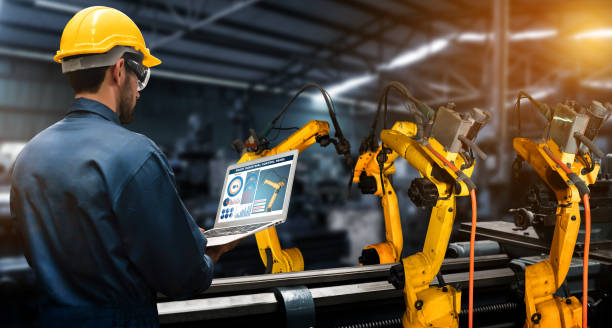Imagine a factory where everything is connected, intelligent, and responsive. Where machines can talk to each other, monitor their own performance, and optimize their operations. Data flows seamlessly from the shop floor to the cloud, providing insights and feedback. Where products can be tracked and traced from the source to the destination. This is not a sci-fi fantasy but a reality in Virginia right now.
SEO 101 Webinar Recap: Gain a Better Understanding of This Cost-Effective Digital Marketing Strategy
Virginia is one of the top US states embracing the Internet of Things (IoT) for smart manufacturing, as Link Lab at the University of Virginia and Virginia-based company Siemens are leaders in the market. IoT is the network of connected devices, machines, sensors, and systems that can communicate and exchange data, creating a digital representation of the physical world.
By using IT solutions for efficient manufacturing operations, manufacturers can transform their factories into smart factories and gain a competitive edge in the global market.
In this blog, we’ll cover:
- How Virginia uses IoT in manufacturing to make factories smarter.
- How Virginia creates the perfect environment for IoT
- What IoT smart factories look like in the future ahead
Making Factories in Virginia Smarter with IoT
Don’t you love it when things just work? That’s what IoT is doing for factories in Virginia. It’s like giving them superpowers but in a very practical, nuts-and-bolts way. Here’s the lowdown on these superpowers:

Monitoring and Controlling
With IoT, factories can always know what’s going on. From temperature to speed, no hiccup goes unnoticed. Rolls-Royce, for example, had their jet engines wearing these “health trackers” at their spot in Prince George’s County, Virginia. However, the factory location closed due to COVID-19 and industry-wise losses. The manufacturing technique has remained a revolutionary breakthrough despite recent challenges.
Optimizing and Automating
IoT helps factories get their act together. It helps them plan better, manage their inventory, assure quality, and get things where they need to go. Take Micron Technology— they’re using IoT and AI to make their chip-making process run like a well-oiled machine in their Manassas, Virginia shop.
Innovating and Differentiating
IoT isn’t just about keeping things running; it’s about taking factories to the next level. With tech like RFID and GPS, they’ve got their products on a tight leash, all the way from the factory to the store. This visibility helps them stay on top of trends, meet deadlines, and never lose a package. According to Bob DePouw, senior manager of upstream logistics at Danone North America, the food and beverage company uses plastic pallets with embedded RFID tags to track its Dannon yogurt shipments. Who knew?
How Virginia is Creating the Perfect Environment for IoT

Beyond using IoT for smart manufacturing, Virginia is creating the perfect environment and ecosystem for IoT development and deployment. Virginia has everything that IoT needs to thrive, such as:
- Infrastructure and connectivity: The state boasts superior connectivity infrastructure, accommodating 70% of the world’s internet traffic and pioneering 5G explorations.
- Education and talent: Over 150 academic institutions produce a steady stream of 40,000+ STEM grads annually, ensuring a robust pool of IT talent.
- Policy and regulation: Strategic initiatives like the Virginia Innovation Partnership Authority encourage IoT adoption and innovation, fostering an IoT-friendly environment.
Read more about the Virginia manufacturing sector in the blog: How Virginia’s Manufacturing Sector is Thriving Despite Global Supply Challenges in 2024.
What Do Tomorrow’s Factories Look Like?
Manufacturers globally are in sync with the revolutionary potential of the Industrial Internet of Things (IIoT)— IoT’s industrial cousin that’s tailoring the tech specifically for advanced industrial applications. Simply put, IIoT links machines with data analytics to create intelligent operations.
Now, it’s hard to overlook IIoT’s growing traction in the industry. Just a quick flashback to last year, the IoT in the manufacturing market stood at over $209 billion. Fast forward to 2026, and we’re eyeing a potential boom to nearly $398 billion, propelled by a yearly growth of 17.4%
So, what’s the future ahead?

AIoT: The Data Dynamo
IoT’s true fortune lies in the data it generates. With estimates pointing towards 80B zettabytes of data by 2025, AIoT transforms this data deluge into actionable insights.
Predictive IoT: Preemptive Strike
Considering the chunky costs of equipment upkeep, predictive IoT’s power to forecast issues before they erupt is a game-changer. We’re looking at increased uptime, reduced costs, and slashed planning time.
Digital Twins & Industrial Metaverse
Digital twins and VR in the industrial metaverse are setting new standards in product creation and maintenance. They’re not just a tech marvel but a revenue booster, too, with potential gains of up to 10%!
Smarter Sensors
As the eyes and ears of IIoT, sensors are evolving. Their market is ready to zoom to a whopping $41 billion by 2030, fueled by the Industry 4.0 revolution and the shift toward predictive maintenance in factories around the country.
5G Capabilities
With 5G, the leap in connectivity is colossal. It’s not just about speedier data transmission— it’s about transforming industries like manufacturing, where real-time data flow can determine between a hiccup and a high-five.
Got IT Support?
Whether you’re a tech newbie or a seasoned pro looking to level up, GENEDGE has got you covered. We offer top-notch IT support for manufacturers. Think technology roadmaps, big data analytics, and all things Industry 4.0.
Ready to boost your operations and profits? Hop on for a free, deep-dive assessment of your business— we do virtual and on-site. Let GENEDGE unveil ways to improve, save costs, and turbo-charge efficiency. Request an Assessment today!


